Lamp Burner Identification
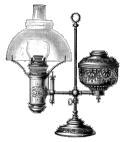
| Reference Desk | Lamp Information | Other Resources | On-Line Shopping |

Purveyors of Antique Lighting and Accessories
435 Main Street
 Hurleyville, New York 12747
Hurleyville, New York 12747
^ Top of Page
Privacy Policy | Terms and Conditions of Use | Announcements
Copyright © 2001-2011 ~ Daniel Edminster | The Lampworks ~ All Rights Reserved
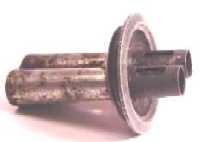 Whale oil burners characteristically have a large portion of the wick tube that extends downward into the oil fount. Because whale oil was quite
thick, especially at cold temperatures, this design
Whale oil burners characteristically have a large portion of the wick tube that extends downward into the oil fount. Because whale oil was quite
thick, especially at cold temperatures, this design 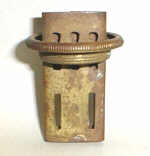 helped to transfer heat from the flame to liquefy the oil. Thus, it was more easily drawn up the wick. Adjustments to the wick are generally made though round or slotted holes in the wick tube with a 'pickwick.' Early whale oil lamps frequently had coarsely threaded pewter burners and collars. As advances were made, more burners were made of brass and the threading got finer. Because pewter is so soft, care must be taken not to cross-thread these old burners or force them onto a collar with different sized threads.
helped to transfer heat from the flame to liquefy the oil. Thus, it was more easily drawn up the wick. Adjustments to the wick are generally made though round or slotted holes in the wick tube with a 'pickwick.' Early whale oil lamps frequently had coarsely threaded pewter burners and collars. As advances were made, more burners were made of brass and the threading got finer. Because pewter is so soft, care must be taken not to cross-thread these old burners or force them onto a collar with different sized threads.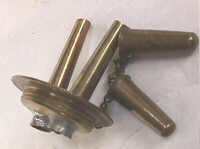 While sometimes found with only a single wick tube, they are most frequently found with two, and occasionally even with three or four (quite scarce) or six (rare). Burning fluid was very volatile and this design transferred heat away from the fuel (unlike the design of a whale oil burner). These burners most often had caps attached to small chains to extinguish the flame and to prevent evaporation of the fluid when not in use (as seen in the picture). Fluid burners were almost always made of brass and had a threaded base. The wicks were adjusted by picking from the wick tube
opening. They do not have holes or slots like whale oil burner tubes.
While sometimes found with only a single wick tube, they are most frequently found with two, and occasionally even with three or four (quite scarce) or six (rare). Burning fluid was very volatile and this design transferred heat away from the fuel (unlike the design of a whale oil burner). These burners most often had caps attached to small chains to extinguish the flame and to prevent evaporation of the fluid when not in use (as seen in the picture). Fluid burners were almost always made of brass and had a threaded base. The wicks were adjusted by picking from the wick tube
opening. They do not have holes or slots like whale oil burner tubes.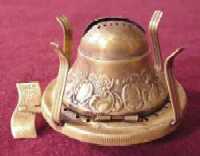 of kerosene burners relates to how air is fed to the flame. Each is described below.
of kerosene burners relates to how air is fed to the flame. Each is described below.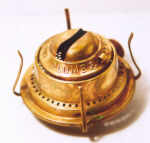 This is a familiar burner style whereby four distinct prongs extending upward are designed to hold the chimney in place. While there are countless variations of the prong burner, the style generally incorporates stylized or embossed brass prongs which "grip" the straight sides of the chimney. Basically, the chimney is held on by friction. The chimney style corresponding to this burner style is called a "slip" chimney. It has straight (flat and parallel) sides near the base and can be 'slipped' into or out of the burner.
This is a familiar burner style whereby four distinct prongs extending upward are designed to hold the chimney in place. While there are countless variations of the prong burner, the style generally incorporates stylized or embossed brass prongs which "grip" the straight sides of the chimney. Basically, the chimney is held on by friction. The chimney style corresponding to this burner style is called a "slip" chimney. It has straight (flat and parallel) sides near the base and can be 'slipped' into or out of the burner.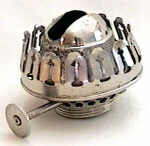 characterized by a circular gallery designed to hold a slip chimney. The other also by a circular gallery, but in this case, the chimney is held not by friction, but by mechanical means. Coronet burners are referred to by
characterized by a circular gallery designed to hold a slip chimney. The other also by a circular gallery, but in this case, the chimney is held not by friction, but by mechanical means. Coronet burners are referred to by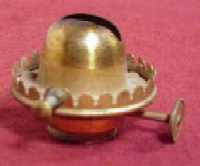 many terms including "lip", "screw", "flange(d)" and "lock(s)-on" burner. The chimney type for this style burner has a flared base which usually slips under one or two tabs on one side of the burner, then is secured on the opposite side by mechanical means. This style of chimney attachment
many terms including "lip", "screw", "flange(d)" and "lock(s)-on" burner. The chimney type for this style burner has a flared base which usually slips under one or two tabs on one side of the burner, then is secured on the opposite side by mechanical means. This style of chimney attachment 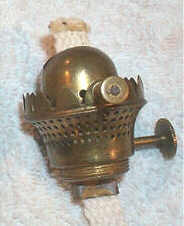 takes on many forms. The more common variations include a set screw (shown on the right), a wire spring clip, or a solid brass clip (
takes on many forms. The more common variations include a set screw (shown on the right), a wire spring clip, or a solid brass clip (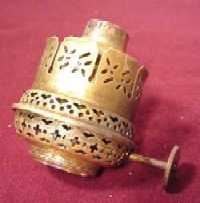 Argand burners apply the principle of increased air supply by way of a central tube surrounded by a round wick. The tube allows combustion air to enter the burner, usually from the sides, and travel up through the opening in the round wick. This burner is designed to fit on any lamp fount - it does not require a central draft tube down through the fount like the next burner.
Argand burners apply the principle of increased air supply by way of a central tube surrounded by a round wick. The tube allows combustion air to enter the burner, usually from the sides, and travel up through the opening in the round wick. This burner is designed to fit on any lamp fount - it does not require a central draft tube down through the fount like the next burner. 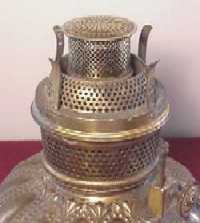 The Central Draft burner is characterized by a central air intake tube surrounded by a circular wick (similar in design to the Argand burner). Combustion air is provided by a series of holes or perforations in the burner sides and top as well as through the center tube (from the bottom of the lamp or fount). This additional air is usually deflected outward toward the flame by a perforated thimble or flame spreader.
The Central Draft burner is characterized by a central air intake tube surrounded by a circular wick (similar in design to the Argand burner). Combustion air is provided by a series of holes or perforations in the burner sides and top as well as through the center tube (from the bottom of the lamp or fount). This additional air is usually deflected outward toward the flame by a perforated thimble or flame spreader.